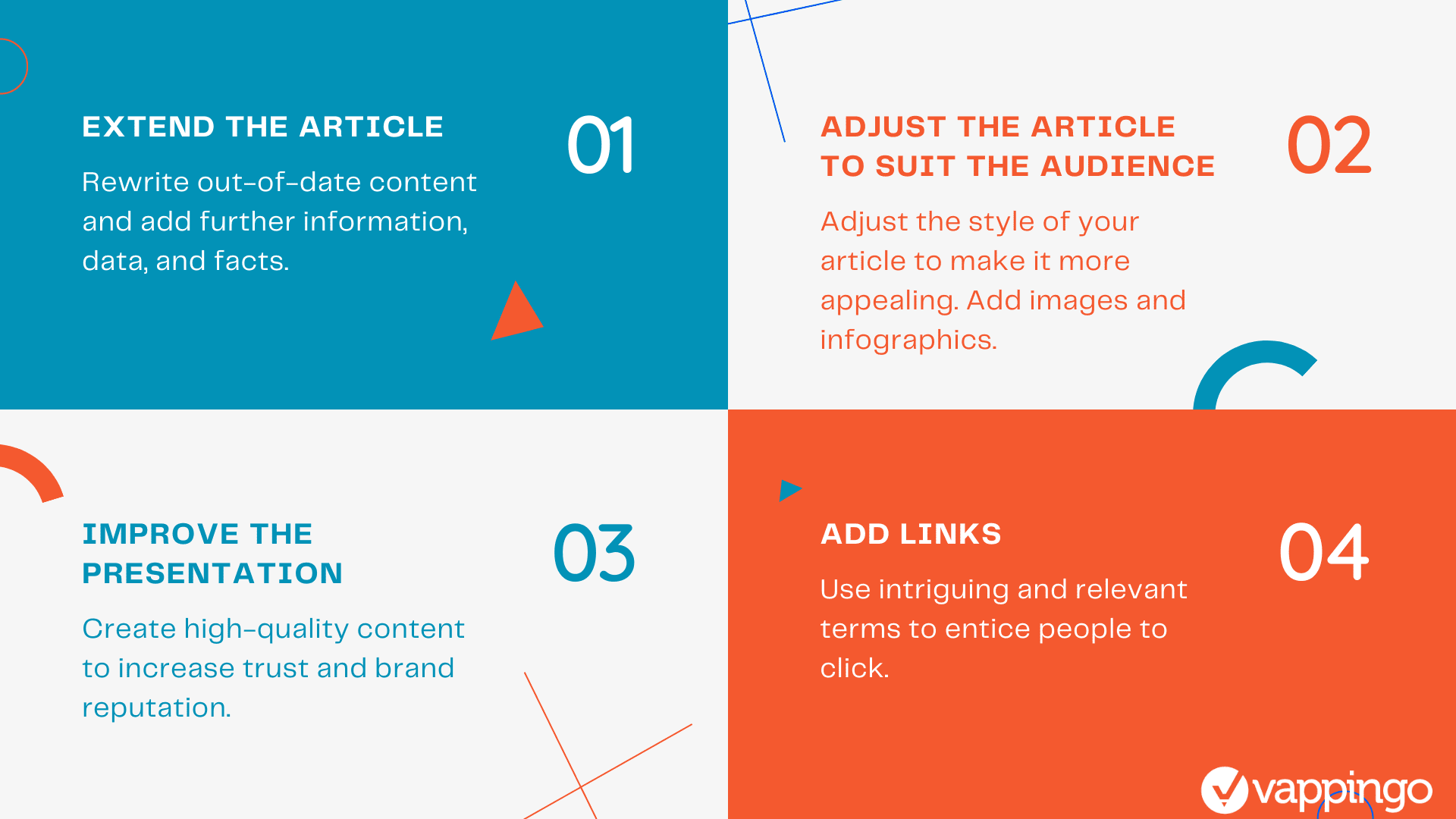Rewriting articles for SEO is a quick and easy technique to improve both search engine optimization and user experience.

Consider the advantages of article rewriting: Higher search rankings, a lower bounce rate, more pages per visit, more social shares, and more repeat visits.
This isn’t a case of too good to be true. It’s a proven fact that article rewriting can fundamentally boost your traffic with minimal effort.
If your website or blog has been around for a few years, it’s likely you have some old content hidden in the depths of the search engine results that rarely get any traffic. Perhaps it is out of date, no longer deemed to be relevant to the keyword you’re targeting, or has been pushed down the rankings because people have published content that Google deems to be superior.
Maybe the article was below the 1000-word minimum recommended today. Or perhaps it didn’t contain any useful collateral, such as infographics and graphics. Alternatively, it may not have any relevant links or lacked a clear keyword strategy.
Regardless of the reasons why your content is not ranking, it could contain useful information that members of your target market would share and appreciate if only they could find it.
If you have old blog posts or articles that share long-term, evergreen content, it’s time to revisit the material and identify what simple steps you can take to enhance its potential and help it reach a much larger audience.
The good news is that you can refresh and improve evergreen material without starting from scratch. Take a look at our guide to how to rewrite articles without plagiarism for more assistance. We have also published a great guide on rewriting articles for content creation.
Here are some simple article rewriting steps you can take to boost your organic traffic without breaking a sweat.
Rewriting Articles for SEO
1) Check the length of the article
It’s widely accepted that enhancing the length of an article can improve its ranking in the search engine results.
It’s not that length counts in and of itself; a poorly written long piece will not engage readers any more than a poorly written short article. If people leave the page after only a few paragraphs (bounce), search engines will notice and assume the article isn’t adding sufficient value. This will translate to a plummet in the search engine rankings.
A well-written long blog post with depth, insight, good grammar, and high-quality material, on the other hand, will enhance engagement and improve ranking. As such, rewriting articles for SEO should be part of every website owner’s basic strategy.
Consider it this way: Will a longer article with more information be ranked higher by search engines than a shorter piece on the same subject with less information? Search engines like Google will, logically, choose the lengthier, more informative, and authoritative piece to display to browsers.
What’s more, if you include useful images, infographics, frequently asked questions, and tabulated data, you have a much higher chance of your site appearing in the featured snippets area of search results. This will significantly boost organic traffic and enhance your brand reputation.
2) Adjust the style of the article to suit your audience
Even if an article is extremely informative, it can still have a terrible style. To put it another way: the flow of the phrases can be clumsy or awkward.
Read your article aloud. Does it sound stilted or natural and engaging?
The length of paragraphs can also make a difference. People are inundated with new pieces of information in every facet of their daily lives. As such, they frequently skim-read or cherry-pick what information they give their attention to.
Adjust the style of your article to make it more appealing. Again, images and stories can help to achieve this as part of your SEO efforts.
3) Improve the presentation of your article
Online media is more visually appealing than books, magazines, and newspapers, but does not carry the same appeal as television.
Even if it is expertly written, a 1,000-word essay without photographs and graphics will be less compelling than one that contains appealing photos, infographics, and images.
Make sure your layout is consistent, neat, and stylish. Engagement and time spent on the website will exponentially increase as the quality of the content improves.
4) Incorporate strategic navigation when rewriting articles for SEO
The navigation bar at the top of the page isn’t the only means by which people can work their way around your site.
It is also useful to include links to other relevant articles (both internal and external) within the body of every article or blog post.
Distribute links evenly throughout the body of the text To establish various, well-spaced exit points and links. Use intriguing and relevant terms to entice people to click. This will be much more effective than randomly scattering links throughout the article.
Finally, because many readers don’t browse all the way to the bottom of a post, bear in mind that links at the bottom of the post will receive fewer hits than those nearer the top. They do, however, draw the attention of at least some readers.

The End Result
Anecdotal data suggests that, if done correctly, rewriting articles for SEO purposes can significantly enhance organic traffic, reduce bounce, and increase social shares.
There are no promises that the article will appear at the top of page one of search results, or that its ranking will increase in any way. Competition from other sites may eventually keep the rating low. However, article rewriting will undoubtedly improve some articles.
Even if rankings don’t improve, higher engagement rates, more social sharing, and a reduced bounce rate (the number of people who come to the page and leave again without looking at another page) will increase the chances of better performance. With a lower bounce rate, the number of pages per visit will grow. For ad-supported websites, this translates to more cash.
Start by analysing the performance of your existing content. Identify what posts are not getting the attention they deserve and think through the steps you can take to improve the laggards and rewrite the material that is already available for SEO purposes.
